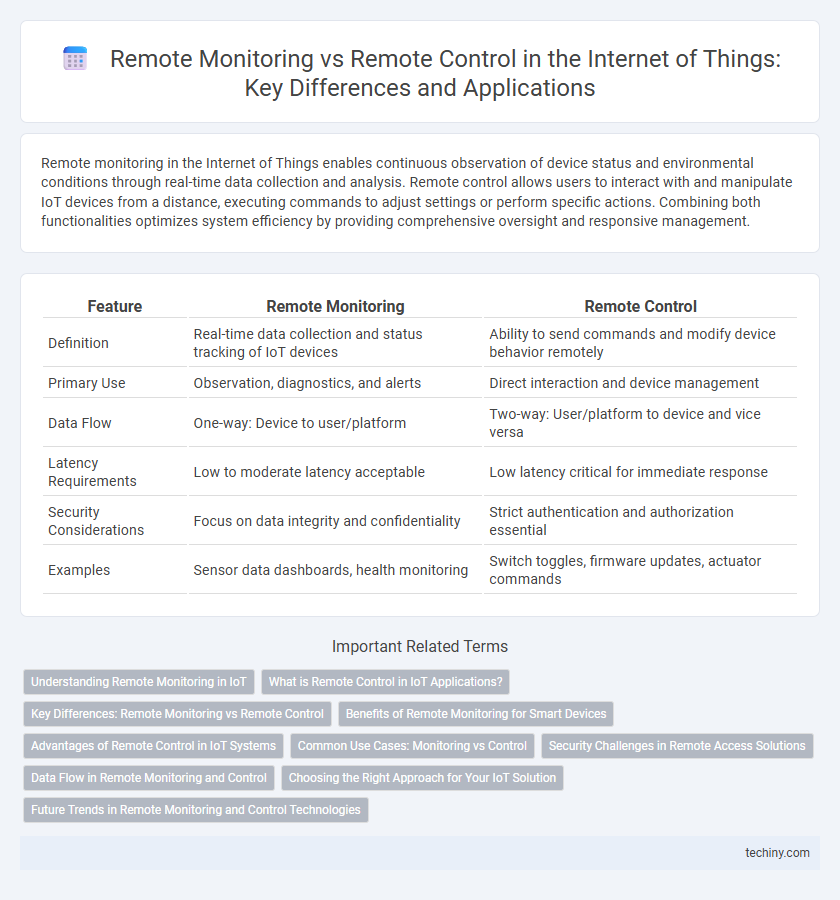Remote monitoring in the Internet of Things enables continuous observation of device status and environmental conditions through real-time data collection and analysis. Remote control allows users to interact with and manipulate IoT devices from a distance, executing commands to adjust settings or perform specific actions. Combining both functionalities optimizes system efficiency by providing comprehensive oversight and responsive management.
Table of Comparison
| Feature | Remote Monitoring | Remote Control |
|---|---|---|
| Definition | Real-time data collection and status tracking of IoT devices | Ability to send commands and modify device behavior remotely |
| Primary Use | Observation, diagnostics, and alerts | Direct interaction and device management |
| Data Flow | One-way: Device to user/platform | Two-way: User/platform to device and vice versa |
| Latency Requirements | Low to moderate latency acceptable | Low latency critical for immediate response |
| Security Considerations | Focus on data integrity and confidentiality | Strict authentication and authorization essential |
| Examples | Sensor data dashboards, health monitoring | Switch toggles, firmware updates, actuator commands |
Understanding Remote Monitoring in IoT
Remote monitoring in IoT involves collecting and analyzing data from connected devices to track performance, detect anomalies, and predict maintenance needs without physical presence. It enables real-time insights through sensors and cloud-based platforms, improving operational efficiency and reducing downtime. Unlike remote control, which allows direct interaction with devices, remote monitoring focuses on observation and data-driven decision-making.
What is Remote Control in IoT Applications?
Remote control in IoT applications refers to the ability to operate and manage connected devices from a distance using internet-enabled interfaces. This functionality allows users to send commands and adjust device settings in real time, enhancing convenience and operational efficiency. Key examples include smart home systems, industrial automation, and healthcare monitoring, where remote control enables immediate response and dynamic interaction with IoT devices.
Key Differences: Remote Monitoring vs Remote Control
Remote monitoring in the Internet of Things (IoT) involves collecting and analyzing data from connected devices to provide real-time insights without altering device states, emphasizing data visibility and condition tracking. Remote control enables direct interaction and manipulation of devices, allowing users to change settings, activate functions, or adjust operations remotely. Key differences include monitoring's passive observation of system performance versus control's active management, where monitoring prioritizes data collection and control prioritizes immediate device response.
Benefits of Remote Monitoring for Smart Devices
Remote monitoring in Internet of Things (IoT) enables continuous real-time data collection from smart devices, enhancing proactive maintenance and reducing downtime. It improves asset management by providing detailed analytics on device performance and environmental conditions without physical presence. This seamless visibility boosts operational efficiency and supports informed decision-making while minimizing security risks associated with direct device manipulation.
Advantages of Remote Control in IoT Systems
Remote control in IoT systems enables real-time interaction with connected devices, enhancing operational efficiency and immediate response to system changes. Unlike remote monitoring, remote control allows users to execute commands and adjust settings from any location, reducing downtime and minimizing the need for on-site interventions. This capability improves automation workflows, optimizes resource management, and supports predictive maintenance through proactive adjustments.
Common Use Cases: Monitoring vs Control
Remote monitoring in the Internet of Things (IoT) often involves asset tracking, environmental sensing, and predictive maintenance to gather real-time data without altering the device's operation. Remote control use cases enable direct interaction with IoT devices, such as adjusting smart thermostats, controlling industrial machinery, or managing lighting systems to optimize energy efficiency. Common applications highlight monitoring for data-driven insights and alerts, while control emphasizes immediate intervention and automation to enhance operational performance.
Security Challenges in Remote Access Solutions
Remote monitoring in IoT enables real-time data collection without altering device functions, minimizing exposure to unauthorized commands but still posing risks like data interception and device spoofing. Remote control involves direct interaction with devices, increasing vulnerability to cyberattacks such as command injection, unauthorized access, and privilege escalation. Robust security challenges in remote access solutions demand encryption protocols, multi-factor authentication, and continuous anomaly detection to safeguard IoT ecosystems from evolving threats.
Data Flow in Remote Monitoring and Control
Remote monitoring in the Internet of Things (IoT) involves continuous data flow from sensors and devices to centralized platforms, enabling real-time status updates and predictive analytics. Remote control extends this data flow by allowing bidirectional communication, where commands from control systems influence device behavior based on monitored data. Efficient data protocols like MQTT and CoAP optimize this exchange, ensuring low latency and secure transmission critical for instant decision-making and automated responses.
Choosing the Right Approach for Your IoT Solution
Selecting between remote monitoring and remote control in an IoT solution depends on the specific application requirements and security considerations. Remote monitoring enables real-time data collection and analytics for predictive maintenance and performance optimization, while remote control facilitates direct interaction with devices for instant adjustments and automation. Evaluating factors such as latency tolerance, user intervention needs, and infrastructure complexity helps determine the optimal approach for maximizing efficiency and reliability in IoT deployments.
Future Trends in Remote Monitoring and Control Technologies
Future trends in remote monitoring and control technologies in the Internet of Things emphasize increased integration of AI-driven analytics to enhance predictive maintenance and real-time decision-making. Edge computing advancements enable faster data processing closer to IoT devices, reducing latency and improving responsiveness for both monitoring and control functions. Enhanced cybersecurity frameworks and interoperable protocols ensure safer, more reliable communication across diverse IoT networks in industrial and consumer applications.
remote monitoring vs remote control Infographic

 techiny.com
techiny.com